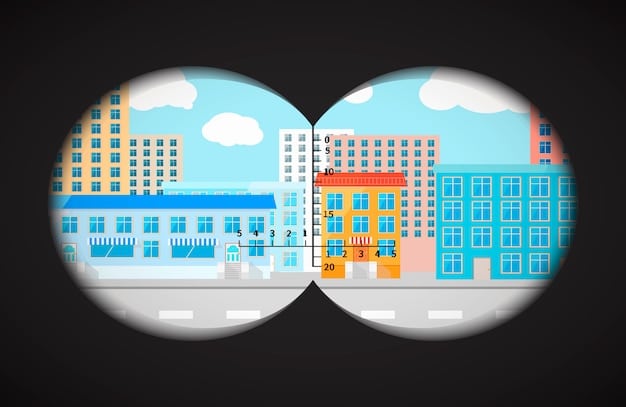Police Reform in the US: Data-Driven Analysis & Impact

Police reform in the US involves evolving policies and practices aimed at enhancing accountability, transparency, and community relations within law enforcement, utilizing data-driven approaches to evaluate effectiveness and impact.
The landscape of law enforcement in the United States is constantly evolving. Today, we delve into **police reform in the US: a data-driven analysis of the latest policy changes and their impact** to understand the complexities and potential pathways forward.
Understanding the Need for Police Reform
Police reform is no longer just a talking point; it’s increasingly becoming a necessity. A series of high-profile incidents involving police misconduct and brutality have fueled public outcry and prompted calls for systematic changes within law enforcement agencies.
But what fuels this urgent need for reform? It stems from a combination of factors, including growing awareness of racial bias in policing, demands for greater accountability, and a desire to build trust between law enforcement and the communities they serve.
Key Drivers of Police Reform
Several factors are driving the momentum behind police reform efforts nationwide.
- Racial Bias Concerns: Studies and lived experiences highlight disparities in policing based on race, leading to demands for equitable treatment.
- Lack of Accountability: Insufficient mechanisms for holding officers accountable for misconduct erode public trust and confidence.
- Community Relations: Strained relationships between police and communities, particularly marginalized groups, necessitate a focus on improving communication and collaboration.
The demand for meaningful change is undeniable. By examining the root causes and addressing systemic issues, we can work toward creating a more just and equitable system of policing for all.

Recent Policy Changes and Reforms
In response to growing pressure, various policy changes and reforms have been implemented across the United States. These initiatives seek to address issues ranging from use of force to community policing strategies.
The scope and effectiveness of these changes vary widely, but they represent a concerted effort to modernize law enforcement practices and promote greater transparency and accountability.
Examples of Policy Changes
A multitude of policy changes are being implemented to address critical gaps in policing practices.
- Use of Force Policies: Many jurisdictions are revising use of force policies to emphasize de-escalation techniques and limit the use of deadly force.
- Body-Worn Cameras: The deployment of body-worn cameras aims to enhance transparency and provide valuable evidence in cases of alleged misconduct.
- Community Policing Initiatives: Community policing programs seek to foster trust and collaboration between law enforcement and local communities through regular interactions and problem-solving partnerships.
These reforms are aimed at addressing specific issues and improving overall policing practices and community relations.
Data-Driven Analysis of Reform Effectiveness
Data plays a vital role in assessing the effectiveness of police reform initiatives. By collecting and analyzing relevant data, we can gain insights into the impact of policy changes on crime rates, community perceptions, and officer behavior.
This data-driven approach enables policymakers and law enforcement agencies to make informed decisions and refine strategies for achieving better outcomes.
Key Metrics for Evaluation
Data-driven analysis relies on several key metrics to evaluate the effectiveness of reform efforts.
- Crime Rates: Monitoring crime statistics before and after policy implementation can help determine whether reforms are contributing to safer communities.
- Community Surveys: Surveys gauge community perceptions of police legitimacy, trust, and satisfaction with law enforcement services.
- Use of Force Incidents: Tracking the number of use of force incidents and associated injuries or fatalities provides insights into the impact of revised policies and training programs.
By carefully analyzing these metrics, we can determine the impact of the various reforms underway.

Challenges and Obstacles to Reform
Despite growing momentum, implementing effective police reform is not without its challenges. Resistance from within law enforcement agencies, political opposition, and funding constraints can hinder progress.
Overcoming these obstacles requires a commitment to collaboration, transparency, and sustained investment in training and resources.
Common Barriers to Reform
Several common barriers often impede the progress of police reform initiatives.
- Resistance from Within: Some officers and police unions may resist reforms that they perceive as overly restrictive or undermining their authority.
- Political Opposition: Political divisions can stall or derail reform efforts, particularly when they become entangled in partisan debates.
- Funding Constraints: Insufficient funding for training, technology, and community engagement can limit the effectiveness of reform programs.
Successfully navigating these challenges requires persistence and a concerted effort to build consensus among stakeholders.
The Role of Community Engagement
Community engagement is crucial for successful police reform. By involving residents, community leaders, and advocacy groups in the reform process, we can ensure that policies and practices reflect the needs and priorities of the communities they serve.
This collaborative approach fosters trust, accountability, and a sense of shared ownership in shaping the future of policing.
Strategies for Effective Community Engagement
Effective community engagement requires a multifaceted approach.
- Town Hall Meetings: Town hall meetings provide platforms for residents to voice their concerns and ask questions of law enforcement officials.
- Community Advisory Boards: Advisory boards composed of community representatives can provide ongoing input and guidance to police departments.
- Collaborative Problem-Solving: Collaborative problem-solving initiatives bring together police officers and community members to identify and address local challenges.
Engaging the community can improve understanding and build better relationships between both parties.
Looking Ahead: The Future of Police Reform
The future of police reform hinges on continued commitment to data-driven analysis, community engagement, and policy innovation. By learning from past experiences and embracing evidence-based practices, we can create a system of policing that is fair, just, and accountable.
This requires a collaborative effort involving policymakers, law enforcement agencies, community organizations, and the public at large.
Key Priorities for the Future
Several key priorities will shape the future of police reform.
- Investing in Training: Comprehensive training programs on de-escalation, implicit bias, and community policing are essential for equipping officers with the skills and knowledge they need to succeed.
- Enhancing Data Collection and Transparency: Comprehensive data collection and transparency is crucial for evaluating the effectiveness of reforms and promoting accountability.
- Promoting Independent Oversight: Independent civilian oversight boards provide a mechanism for investigating complaints of misconduct and ensuring fair and impartial outcomes.
With sustained effort and a commitment to continuous improvement, we can create a system that better serves and protects all members of society.
| Key Point | Brief Description |
|---|---|
| 🚨 Use of Force Policies | Revisions emphasize de-escalation and limited deadly force. |
| 📹 Body-Worn Cameras | Enhances transparency and provides evidence of misconduct. |
| 🤝 Community Policing | Fosters trust through interactions and partnerships. |
| 📊 Data-Driven Analysis | Evaluates reform effectiveness and informs future strategies. |
[Frequently Asked Questions]
What is police reform?
▼
Police reform refers to the process of changing policies, practices, and organizational structures within law enforcement to improve accountability, transparency, and community relations.
▼
Police reform is necessary to address issues of racial bias, police misconduct, and strained community relations, and to build trust and ensure fair and equitable treatment for all.
▼
Examples include revised use of force policies, implementation of body-worn cameras, community policing initiatives, and independent civilian oversight boards.
▼
Data is used to evaluate the effectiveness of reform initiatives, track crime rates, monitor use of force incidents, and assess community perceptions of police legitimacy.
▼
Community engagement is crucial for ensuring that reform policies reflect the needs and priorities of the communities they serve, fostering trust, and promoting shared ownership in shaping the future of policing.
Conclusion
Police reform in the US represents an essential step towards creating a more equitable and just society. By focusing on data-driven approaches, community engagement, and policy innovation, we can build a system of policing that enhances public safety while upholding the rights and dignity of all individuals.





